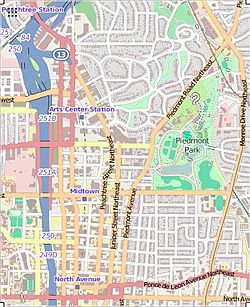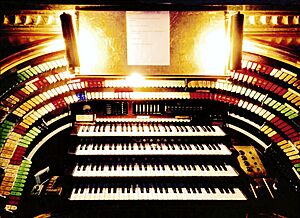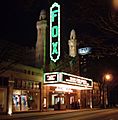Fox Theatre (Atlanta) facts for kids
 |
|

Fox Theatre in 2024
|
|
| Address | 660 Peachtree Street NE Atlanta, Georgia U.S. |
|---|---|
| Owner | Fox Theatre Inc. |
| Type | Movie Theater Palace |
| Capacity | 4,665 |
| Screens | 1 |
| Construction | |
| Opened | 1929 |
| Reopened | 1991 |
| Tenants | |
| Broadway Across America | |
|
Fox Theatre
|
|
| Architect | Olivier J. Vinour |
| Part of | Fox Theatre Historic District (ID78003178) |
| NRHP reference No. | 74002230 |
| Significant dates | |
| Added to NRHP | May 17, 1974 |
| Designated NHL | May 11, 1976 |
The Fox Theatre, also known as the Fabulous Fox, is a famous performing arts center. It's located at 660 Peachtree Street NE in Midtown Atlanta, Georgia. This amazing building is the main part of the Fox Theatre Historic District.
The theater was first planned as a big temple for a group called the Shriners. That's why it has a special Moorish design. The huge 4,665-seat hall was later turned into a fancy movie theater. It opened in 1929 as part of the Fox Theatres chain.
Today, the Fox Theatre hosts many different shows. You can see the Atlanta Ballet perform there. They also have a summer film series. Big Broadway shows on tour often stop at the Fox. Sometimes, popular music artists also hold concerts here.
Contents
Exploring the Fox Theatre's Design
When the Fox Theatre first opened, people were amazed. A local newspaper said it had "a picturesque and almost disturbing grandeur beyond imagination." Even today, it still impresses everyone who visits. The main architect for the project was Olivier Vinour.
The Fox Theatre's design mixes two main styles. The outside of the building, the main hall, and some lounges look like Islamic architecture. The Egyptian Ballroom and other lounges are designed like ancient Egyptian architecture.
The main hall has 4,665 seats. It was built for both movies and live shows. It looks like an Arabian courtyard under a night sky. There are 96 crystal "stars" in the ceiling. About a third of these stars even flicker! Clouds are projected onto the ceiling, slowly moving across this "night sky."
The Egyptian Ballroom looks like a temple for Ramses II in Karnak, Egypt. In the ladies' lounge, you can find a copy of King Tut's throne chair. The makeup tables even have tiny Sphinxes! In the Islamic parts of the theater, there are decorative fountains.
The Fox Theatre uses a lot of trompe-l'œil. This is a French term meaning "deceive the eye." For example, "wooden" beams are actually made of plaster. Paint that looks like gold is not real gold. Some areas are painted to look like they have outside light. The fancy fireplaces were never meant to have working chimneys. Even the giant "tent" in the main hall is plaster and steel. It helps the sound travel better.
You can take guided tours to see all these amazing details inside the Fox Theatre.
A Look at the Fox Theatre's Past
The Fox Theatre was first planned as the Yaarab Shrine Temple. This was going to be the main building for a group of 5,000 Shriners. The project cost $2.75 million, which was too much for the Shriners. So, they rented the main hall to William Fox. He was building movie theaters all over the country.
The theater opened on December 25, 1929. This was just two months after the stock market crash and the start of the Great Depression. A week later, the Shriners opened their part of the building. It had offices, a lounge, a ballroom, a kitchen, and practice rooms. The Shriners continued to rent space in the building until 1949.
The Fox Theatre faced tough times early on. It closed just 125 weeks after opening. The Shriners couldn't pay their bills, and William Fox went bankrupt. In December 1932, the entire building was bought by Paramount Pictures and Lucas & Jenkins.
In 1939, the famous movie Gone with the Wind premiered in Atlanta. It showed at the Loew's Grand Theatre, not the Fox. But the big parade for the movie started right outside the Fox. This was because the movie's stars were staying across the street.
During the 1940s, the Fox Theatre became one of Atlanta's best movie theaters. The Egyptian Ballroom became a popular dance hall. It hosted many famous big bands and country music groups. The Fox was also special because it was the only theater in Atlanta that allowed both white and black people. However, there were separate entrances and seating areas. These historical features are still there today for educational purposes. The theater became fully integrated in 1962.
In the 1970s, the Fox Theatre started to decline. Many people moved to the suburbs. New movie theaters with multiple screens opened there. In 1974, a phone company called Southern Bell wanted to buy the theater. They planned to tear it down to build a parking garage.
A group quickly formed to save the theater. It was added to the National Register of Historic Places in May 1974. Many people protested, including famous entertainers like Liberace and Lynyrd Skynyrd. The city refused to allow the demolition. A special deal was made to save the Fox. The Southern Bell Building was built next to the theater. The U.S. Department of the Interior then named the Fox a National Historic Landmark in May 1976. They recognized its unique architecture.
After being saved, the Fox Theatre went through a long and costly restoration. Many original decorations were still there. New parts were made using old photographs. Today, the Fox looks much like it did when it first opened. Some additions that were planned but couldn't be built in the 1920s are now included. The building has also been updated to meet modern safety rules.
The Fox is now the only old movie palace left in Atlanta. Other famous theaters are gone or have changed. The Fox Theatre is run by a non-profit group called Atlanta Landmarks, Inc. It hosts many cultural events. These include the Atlanta Ballet's annual The Nutcracker shows and Broadway tours. Because it was built as a movie house, the stage is not very deep. This means some very large modern shows need special changes to fit.
In June 2006, the theater got a new digital movie projection system. It was first used to show The Chronicles of Narnia: The Lion, the Witch and the Wardrobe. The sing-alongs before each movie are still shown using the original 1929 Brenograph Movie projector.
The Egyptian Ballroom and the Grand Salon are often rented for events. These include parties, fundraisers, weddings, and school proms.
Since 1975, the Fox has made a profit every year. About 750,000 people visit the Fox each year. The famous musician Prince performed his final concert here in April 2016. In May 2017, Col. Bruce Hampton passed away after collapsing on stage during his 70th birthday concert at the Fox.
In February 2019, the Fox hosted the NFL Honors event. This was before Super Bowl LIII at Mercedes-Benz Stadium.
Many famous musicians have played at the Fox Theatre. These include Elvis Presley in 1956, Bruce Springsteen in 1976, 1978, and 1996, and Bob Marley and the Wailers in 1979. Pearl Jam played there in 1994, and the Rolling Stones in 1981. Georgia bands like the Allman Brothers played in 1980 and recorded their live album, Fox Box, there in 2004. Other artists include Ray Charles (1983), James Brown (1985), R.E.M. (1989), the B-52's (1989, 2022), the Black Crowes (1992), Alan Jackson (1992), Widespread Panic (1993), Collective Soul (1996), Jeff Foxworthy (2001), Outkast (2001), Indigo Girls (2004), Zac Brown Band (2009), Monica (2010), Mastodon (2017), Manchester Orchestra (2018), Drivin' N' Cryin' with Drive-By Truckers (2019), Blackberry Smoke (2019), Travis Tritt (2019), and The Georgia Satellites (2022).
On September 17, 2024, the Fox Theatre hosted "Jimmy Carter 100: A Celebration in Song." This concert celebrated the 100th birthday of former president Jimmy Carter. It featured many musicians and celebrities.
In July 2025, the Fox hosted The Tonight Show Starring Jimmy Fallon. This was part of the events for the 2025 Major League Baseball All-Star Game.
The Mighty Mo Organ
The Fox Theatre has a huge pipe organ called the "Mighty Mo." It has four keyboards and 42 sets of pipes. This organ was custom-built for the Fox by M. P. Möller, Inc. in 1929. With 3,622 pipes, it's the second-largest theater organ in the United States. It was the biggest theater organ Möller ever built.
The Mighty Mo is a true theater organ, not a church organ. Its pipes range from 32 feet (about 10 meters) tall to the size of a small pen. It's designed to sound like a full orchestra. Besides pipes, it has a marimba, xylophone, glockenspiel, drums, sleigh bells, a gong, and even a six-foot (1.8m) grand piano. It also has many sound effects for silent movies, like car horns, thunder, and bird whistles. What's special is that it also has 12 sets of pipes for a church organ. This means it can be played as both a theater organ and a church organ. The Mighty Mo is one of the few organs that are still in the theaters they were built for.
Larry Douglas Embury was the theater's main organist from 2002 until he passed away in February 2016. He played the Mighty Mo during the Fox's summer film festival. He also played for the Atlanta Ballet's annual The Nutcracker show. In September 2002, he hosted "Fox at the Fox." This concert honored the famous organist Virgil Fox, who played many concerts on the Mighty Mo in the 1970s.
A Secret Apartment Inside
The Fox Theatre also has a 3,640 square foot (338 square meter) apartment. This was the home of Joe Patten, who was the technical director from 1974 to 2004. Joe Patten was born in 1927 and passed away on April 7, 2016. He was given a special deal to live in the apartment rent-free for his whole life.
Patten first got involved with the Fox when he volunteered to fix the theater's Moller pipe organ. He was also very important in the effort to save the Fox from being torn down. The apartment is in a space that the Shriners used as an office. The walls of the apartment are very thick, about 2 to 3 feet (0.6 to 0.9 meters). A secret path leads from the bedroom to an old spotlight platform high up in the main hall. There's also a separate entrance directly to the street.
Joe Patten is credited with saving the Fox from a fast-moving fire in April 1996. The fire started in the attic wiring before dawn. It caused $2 million in damage. But the damage would have been much worse if Patten hadn't been there to call the fire department right away.
After Patten's passing, Atlanta Landmarks, the group that owns the Fox, didn't have a clear plan for the apartment. They said it could be used for dressing rooms or rehearsal spaces. They also said it was unlikely anyone else would live there.
In August 2010, there was a disagreement between Patten and Atlanta Landmarks. Patten said he was being asked to leave his apartment. But Atlanta Landmarks said they wanted to create a new lease that would help with Patten's health needs. They stated he was still welcome to live there.
Images for kids
-
Mitski performing in the theatre in 2024
More to Explore
- Fox Theatre Historic District
- Fox Theatre for a list of other Fox Theatres
- List of National Historic Landmarks in Georgia (U.S. state)
- National Register of Historic Places listings in Fulton County, Georgia
- Detailed backstage visit and equipments










